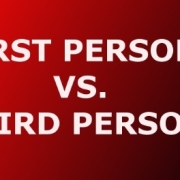First-person or third-person or somewhere in between?
It is perhaps the most important thing you have to ask yourself as an author. How will I pass on my story? What’s the best means of conveying the actions and emotions? Are things better communicated through the eyes of the author/narrator (first person) or from an almost dispassionate distance as the messenger/teller of events (third person)?
We’ll immediately discount the in-between option of second person writing – the method by which an author attempts to put the reader at the forefront. Example: “You know walking into a room what you’re going to find, and it comes as no surprise when you find it.” It’s tedious and rarely used, if only because of the extreme difficulty in being able, with any degree of satisfaction, to bring the reader along for a 300-page constant repetition of the word ‘you’.
That leaves us squarely with the first- or third-person options. Let me admit straightaway that, as a general rule, I don’t like my fiction wrapped up in first-person narratives. With a few notable exceptions, most of the attempts at “me” and “I” stories come across as self-indulgency on the part of the author. I’m so set in my ways on this score that when I scan bookshelves, or ‘click to look inside’ a Kindle book, I invariably move on to another when I see the dreaded first person emerging!
I mentioned exceptions, and they are brilliant ones at that. Lee Child takes his Jack Reacher character on first-person journeys – and I’m first in the queue to buy them., although I prefer those where he uses the third-person option. Similarly with Matt Hilton and his Joe Hunter character, although in Matt’s case he cleverly mixes first- and third-person chapters. James Patterson too is a master at the mix ‘n match art, and there are many others whose success at these styles undermine my argument.
Despite that, I won’t be shaken from the belief that most authors, particularly first timers, should steer away from the first-person trap. It takes a special blend of skill and experience to put these kinds of stories in front of readers. Frankly, unless there’s a compelling reason to write in the first-person, stay well clear!
Call me a set-in-my-ways, two-fisted kind of no-nonsense guy who doesn’t believe in turning the other cheek and likes nothing better than a beer with my mates after work – STOP! What’s with the macho first-person stuff? See what I mean?
Seriously though, there is an art to first-person storytelling that sets it apart from the more flexible third-person methodology. Yes, I know we all crawl into make-believe worlds and dream up characters, many of whom are probably the bits and pieces of the kind of person we would like to believe we could be ourselves. We can therefore be just as self-indulgent in telling our tales through the third person as those who prefer the first-person.
There are, however, other important factors to consider. Generally, you can’t juggle a number of plotlines within a story which is told in the first-person (other than by using the difficult mix ‘n match methodology referred to earlier). As a rule, you require the constant presence of the hero/heroine to be able to recount, in the first person, what is going on. That means your tale tends to be linear – each scene moves in a monotonous straight line as told through the eyes of the narrator who needs to be in each scene to be able to recount to the reader what is taking place.
Balance this against the third-person ability to juggle a number of plotlines – which can be years and continents apart – and have them converge in a way that is enjoyable for the reader. Readers know that different threads and plots will eventually come together, but it adds greatly to their enjoyment if as a writer you can get them to guess and anticipate how the various strands will meet. As well as enjoying the individual components of the story, readers are compelled to turn pages to see if the convergences will occur as they think they will.
The arguments for and against first-versus-third have equal force across all genres. No matter what you’re writing it’s important to consider the best vehicle to get YOUR story across to readers. The general rule is that you’re aiming for reader enjoyment. If you truly believe a first-person narrative will best achieve this, then go for it.
For my part, I will continue to believe implicitly in the view-from-above art of storytelling’ First-person stories are generally not my cup of tea – and I suspect I am not alone.





Leave a Reply
Want to join the discussion?Feel free to contribute!